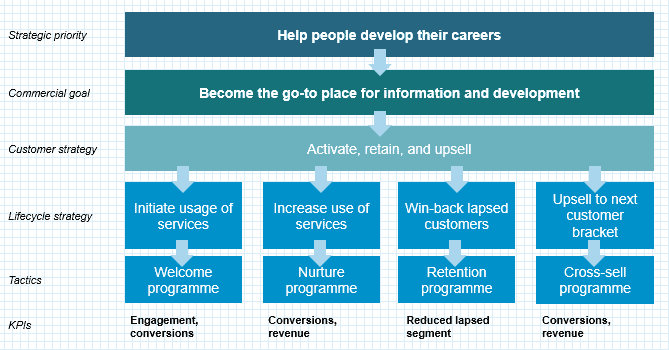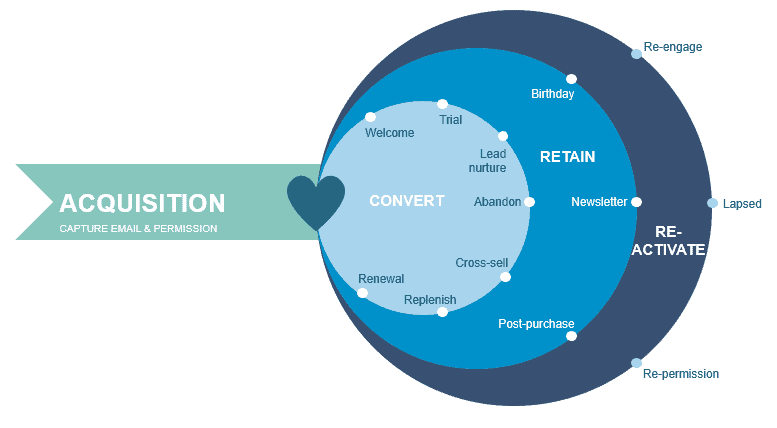Recently in the news, you may have seen British Airways facing a few email issues off the back of the pilots’ strike. It looks like an itchy trigger finger sent a flight cancellation email to customers, only for flights to be reinstated hours later. But this got me thinking, what role could a First-Person Marketing (FPM) strategy play in averting disaster?
Firstly, a reminder on what we mean when we talk about FPM. First-Person Marketing is the evolution of digital marketing, which seeks to make it possible to deliver 1:1 communications at scale. It works by integrating personalization, automation, integration, and optimization to ensure the right person gets the right message at the right time via the right channel.
It’s about leveraging customer data from your whole ecosystem – like behavioral data, email metrics, demographics, preferences and purchase history – to enable prediction, testing and refining. This leads to increases in efficiency, intelligence and performance and ultimately can enable true one-to-one communication with your audience, bringing revenue growth while saving time, money and resources. (For more on FPM, check out our blog on the topic by clicking here.)
In one respect, BA got FPM right. They used the data they had to ensure they were targeting the right customers with the cancellation – those who were traveling to specific locations on specific dates. Every cloud, right? But there is a way to avoid disasters like these, and that’s through good strategic planning.
I know what you’re thinking – how can strategy and planning help with handling an unpredicted situation? By implementing a robust calendar of marketing activity, your marketers are freed up to focus on two things: the customer and being responsive.
Here at Upland Adestra, when we begin working with our customers, one of the first questions I always ask is: “Do you have a strategy, and can you explain it to me?”. Now, I’m not expecting them to pull out a 20-page long document outlining everything (although this is always appreciated!), but you cannot underestimate the importance of knowing what you want to achieve and the steps you’re going to take to get there. Put simply, this is current-future state: where you are now, and where you want to be. The plan will tell you how to get there.
Once we have an understanding of our clients’ email marketing aspirations, we then work with them by challenging them to be clear on goals.
Recently, I worked with a large organization, exploring how their overall company strategy could be reflected in their email strategy, distilling the overarching goal into tactics. By working down through commercial goals, customer strategies and lifecycle strategies, we were able to come up with the below (although this snapshot is heavily anonymized). What this exercise produced was a series of KPIs focussing on how email was directly tied into the company’s overarching strategy – yes, it is possible!

Once the aims are clear, it’s time to turn the concept into tangible actions to implement – and this is where putting yourself in the shoes of the customer comes into play. I’ve always said FPM can be distilled into three classic tenets of marketing: right person, right message, right time. Let us consider for a moment the diagram below of what a customer lifecycle could look like:

This is a model Upland Adestra use across B2B and B2C to identify potential customer touchpoints. With the aforementioned example in mind, you can see how you can start to map commercial goals to the customer lifecycle. As the company strategy is to help people in their career development, you can see how the different lifecycle stages will help drive this. Let’s take a look at two examples of how this works in reality:
Welcome journey:
This is your entry-level and potentially the most important automation you can have in place. This programme gives you the chance to build a relationship with your customer: introduce yourself and your brand; build trust; and use email to build a two-way relationship. This is known as progressive profiling – a separate, but important topic which we’ll cover in a blog at a later date. In the plan above, the welcome journey is identified as an opportunity to initiate use of services, so this is your chance to demonstrate the value. And it always comes back to the value exchange: the customer has trusted you with their data, so build on that trust by demonstrating how well you’re going to use it.
Birthday automation:
I know, you weren’t expecting me to pick this one! But I’m a big fan of the marketing tenets and one of the fundamentals is to always attempt to ‘surprise and delight’ your customers. If they’ve provided you with their date of birth – which is another level of personal information – make sure you use it and send them a special treat. Of course, there is value to your business when it comes to profiling and segmenting your customers, but make sure you are acknowledging this and rewarding them for complying.
By now you’re probably wondering how this relates to the BA trigger-happy issue but stay with me here. You’re also probably thinking this sounds like a lot of work – and you would be right – but it truly is worth investing the time and resource to look into how a company-wide strategic objective ties down into email tactics. Time and time again we see strong returns on investment in this area from Adestra clients. By the time you have distilled your strategy in tactics and KPIs, you have your plan, priorities and approach. So, it’s time to set the wheels in motion.
The main thing to take from this approach is that a lot of what you need to achieve can be done through automation. The up-front investment in time and technology pays off dividends when you have systems talking to each other and transferring data, message content, design elements and timings automatically. And as a bonus, your customers are on the receiving end of the journey you have designed for them – one that will engage them, drive brand loyalty, and move them on to the next stage in their lifecycle. It’s that lifecycle nudge that’s important as it ties into your overall strategic objective.
But there’s another point to this approach of putting the grunt in up-front: it frees up your marketers’ time to focus on other things. This ensures they have time set aside to learn, test, and optimize as you go, tweaking things so you are incrementally improving your results. And if you’re BA, it would hopefully mean you have the resource to hand to leave the day-to-day to run automatically, so that when a crisis hits, you’re not panicking and sending out an email in error.
Alternatively, you could always invest in an email approval feature…

